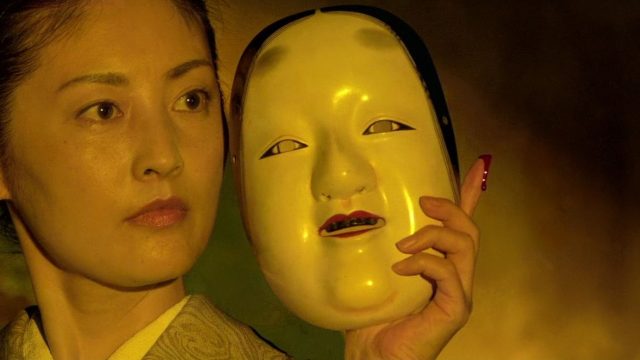This Week You Will Bake Your Noodle With:
- obscure streams
- fading subcultures
- microtonal music
- work balance
- personal essays
Thanks to Miller for providing food for thought this week. Send articles throughout the next week to ploughmanplods [at] gmail, post articles from the past week below for discussion, and Have a Happy Friday!
A.S. Hamrah picks ten of the best films on obscurity/rarity streamer Ovid:
Hanagatami (Nobuhiko Ōbayashi, 2017): A heartbreaking dissection of Japanese nationalism set on the eve of World War II, this melodrama from the director of House (1977) is the third of four movies from his final period, a wild, late flowering that began in 2012 with Casting Blossoms to the Sky and continued through his final testament, the crazy epic Labyrinth of Cinema (2019). Ōbayashi uses computer-generated effects with an abandon unseen in more naturalistic films, a simultaneous revel in digital artifice and a justification for its existence. He created a dizzying world that, in Hanagatami, reflects the fraught psychology of his teenage characters, several of whom look forty years old. As their country slides into war, they decline into tragic perversities, including delicate vampirism and homoerotic midnight nude horseback rides on the beach, presented by Ōbayashi as if he is making a film out of Archie comics.
Mireille Silcoff mourns for the teens of today and the loss of meaningful subcultures at The New York Times Magazine:
To me, this is tragic, and I feel annoyed on their behalf. So I will risk sounding like an old raver shaking her cane to note that subcultures, even the vapid ones, used to tie their participants to people and places. Getting into a scene could be work; it required figuring out whom to talk to, or where to go, and maybe hanging awkwardly around a record store or nightclub or street corner until you got scooped up by whatever was happening. But at its deepest, a subculture could allow a given club kid, headbanger or punk to live in a communal container from the moment she woke up to the moment she went to bed. If you were, say, a suburban California skate rat in 1990, skating affected almost everything you did: how you spoke, the way you dressed, the people you hung out with, the places you went, the issues you cared about, the shape of your very body. And while that might not have seemed a promising plan for teenage well-being at the time, by today’s standards of diffuse loneliness and alienation among youth, it looks like a very good recipe indeed — precisely the kind of real-world cultural community that has been replaced by an algorithmic fluidity in which nothing hangs around long enough to grow roots.
For WBEZ Chicago, Hannah Edgar examines how the Windy City became a hub for microtonal music:
For Acoustic Microtonal, [Mike (Ed’s brother!)] Sheeran arranged Easley Blackwood’s Etudes, originally for electronic keyboard, for a classical chamber ensemble. Much like Blackwood’s synthesized originals, Sheeran’s arrangements of the Etudes manage to sound familiar to the lay-listener — even beautiful. The fourth etude nods to Indonesian traditional music — Sheeran casts a hyperactive harp to step in for the bell-like percussion choir found in gamelan ensembles. He gives Blackwood’s impressionistic second etude a lush orchestration; far from grating, it sounds like it could have come from the pen of French composer Maurice Ravel, a mainstay on Chicago Symphony programs.
Peter N. Limberg’s Less Foolish attempts to find “the virtuous mean between time drunkenness and work martyrdom“:
In philosopher Josef Pieper’s Leisure: The Basis of Culture, true leisure is a kind of spiritual silence, fostering a timeless state and opening one toward the whole. Leisure is not the cessation of work but a contemplative disposition that puts work in its proper place. This leisure ontology has gradually dissipated from everyday life, with a working ontology capturing more of our “time,” instrumentalizing everything toward work. Time drunks deeply intuit this, and their procrastination-induced state of timelessness should not be considered a terrible character flaw but rather an act of spiritual rebellion against modernity. […] The work martyr acts foolishly by sacrificing the wrong thing for the wrong reason toward the wrong person. However, the selfless spirit of their sacrifice is correct. While the drunks get the timeless piece right, the martyrs get the selfless piece right. One should not be working for their egos, greedily hoarding material luxuries, but they should work for those they live for and toward the wise lifestyle they are called to live.
And at her substack, Terry Nguyen considers the rise and fall of the online personal essay:
In the era of Lived Experience, readers hungered after the plate of personal truths presented in the essay, no matter how outrageous or enraging or navel-gazey. Some of us (mostly women) found ourselves relating to these essayists (mostly white women). We thought them to be good, well-meaning people, and so we thought their essays, the medium by which they delivered their message, must also be good. That is, until they proved themselves to be narrow-minded or problematic, which made their work, by default, bad. As reader-voyeurs, our judgments are muddied by our preoccupation with the writer. Rather than assessing her on a level of style or craft, her relevance is determined by her message, her perceived moral value. Publication, in turn, becomes validation, a condition of acknowledgement that one’s story is worth telling or, worse, right or good.


